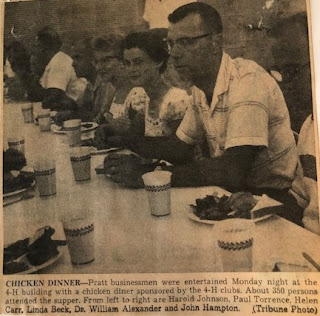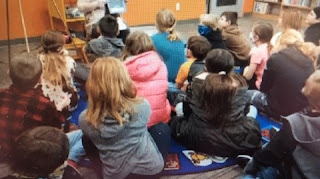In Isaac Werner's day Newspapers were extremely important. In cities there were morning and evening editions, with special editions if something important happened. For those who did not live in cities, like Isaac, their local weekly newspaper brought not only local news but also stories rewritten from the city newspapers.
A century later, with radio and television, we were able to get our news more quickly, but local newspapers remained important. My family subscribed to four different newspapers at least some of the time while I was at home--Pratt, St. John, Hutchinson, and the weekly Macksville paper.
At the close of the day, the family watched the CBS station hosted by Walter Cronkite, who was such a familiar and trusted newsman that he acquired the nickname of 'Uncle Walter.'
Times have obviously changed, and today newspaper are struggling. Those changes have brought us immediate access online, as well as television news. But, one of those changes is the blurring between newscasters and commentators.
To understand the difference between those two roles let me first share the Journalist's Code of Ethics.
1. I shall scrupulously report and interpret the news, taking care not to suppress essential facts nor to distort the truth by omission or improper emphasis. I recognize the duty to air the other side and the duty to correct substantive errors promptly.
2. I shall not violate confidential information on material given me in the exercise of my calling.
3. I shall resort only to fair and honest methods in my effort to obtain news, photographs and/or documents, and shall properly identify myself as a representative of the press when obtaining any personal interview intended for publication.
4. I shall refrain from writing reports which will adversely affect a private reputation unless the public interests justify it. At the same time, I shall write vigorously for public access to information as provided for in the constitution.
5. I shall not let personal motives or interests influence me in the performance of my duties; nor shall I accept or offer any present, gift or other consideration of a nature which may cast doubt on my professional integrity.
6. I shall not commit an act of plagiarism.
7. I shall not in any manner ridicule, cast aspersions on or degrade any person by reason of sex, creed, religious belief, political conviction, cultural and ethnic origin.
8. I shall presume persons accused of crime of being innocent until proven otherwise. I shall exercise caution in publishing names of minors, and women involved in criminal cases so that they may not unjustly lose their standing in society.
9. I shall not take unfair advantage of a fellow journalist.
10. I shall accept only such tasks as are compatible with the integrity of my profession, invoking the 'conscience clause' when duties imposed on me conflict with the voice of my conscience.
11. I shall comport myself in public or while performing my duties as journalist in such manner as to maintain the dignity of my profession. When in doubt, decency should be my watchword.
Without commenting on my observations of how well today's journalists are adhering to their Code of Conduct, I will only say that we have come a long way from 'Uncle Walter,' but it is significant that the ideals of the Journalists' code remain.
What has crowded into "news" is commentary rather than journalism. There are many problems as a result, and at the top of the list is that many people do not recognize the difference. To balance this consideration of journalism and commentary I would like to be able to include the Commentators' Code of ethics. Unfortunately, I have not found any such Code for Commentators. That in itself says a lot.
Newspapers have long had Opinion Columns, clearly identified as such. Perhaps a good place to start considering how commentators became so prevalent is with the coverage of the O.J. Simpson trial. Many people followed that closely, and commentators were used to help explain legal rules of evidence. Since then, the use of Commentators has only grown.
In today's competitive world of news reporting, often reporters and journalists are dealing with incoming news in real time. They are trying to report the news when they lack the needed expertise on the subjects. In the past they would have been expected to research what they needed to know, but real time reporting does allow time for research. To help with that problem, experts are often sitting beside them to offer such explanations as historic comparisons, related political issues, laws, previous court rulings, and countless other matters. Who are these "experts" and what is the extent of their expertise? Most of the time, we do not know.
There is a huge difference between a Commentator with a knowledge of the topic under discussion vs. a Commentator lacking adequate knowledge of the topic or spouting his or her opinion rather than sharing informed knowledge to help journalists and viewers better understand the issues being reported. Even a knowledgeable commentator must be aware of speaking beyond his or her expertise or wandering off into opinion.
If journalists have chosen to be guided by a Code of Ethics, shouldn't those Commentators who are willing to present themselves as experts in their fields also be willing to accept a Code of Ethics for Commentators?
Here are some suggestions to consider:
1. Lawyers are familiar with the duty to avoid a conflict of interest. Should a commentator consider whether he or she can avoid a conflict of interest regarding the subject or the person involved, and either recuse themselves or at least disclose the potential conflict.
2. If a commentator has gained his or her expertise through the person about whom the topic concerns, how should that impact any confidentiality the person may have expected?
3. If a commentator puts him or herself out there as an expert, shouldn't the training, experience, education, or whatever is regarded as creating expertise be disclosed.
Americans value freedom of speech, and it is a right to be protected. However, some commentators take that freedom as the right to express their opinions about whatever they choose, and they occupy settings that give the impression of expertise they may not have.
The importance of Americans being well informed in our complicated world is obvious. Reflecting on ways to protect our access to information without exposing us to misinformation in disguise is a challenging issue but remains one worth trying to protect.
There could be no better example of the importance of journalism than events happening right now throughout the world. Yet, when I began drafting this blog, there was no invasion of Ukraine. The reality is that the need for journalists is always essential, and the importance of accurate reporting and commentary never disappears!










